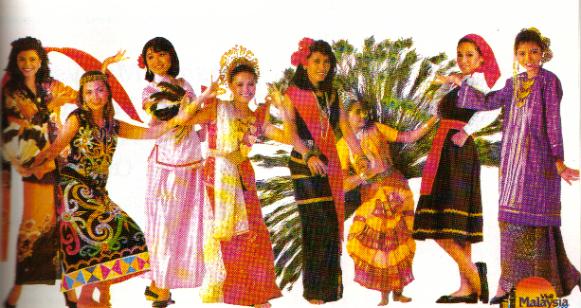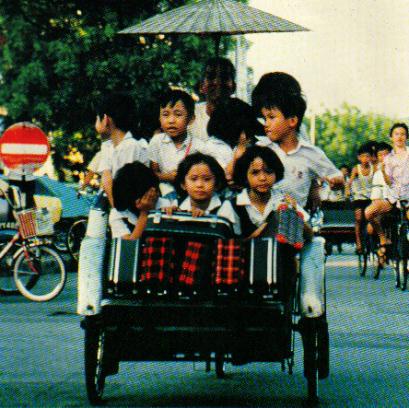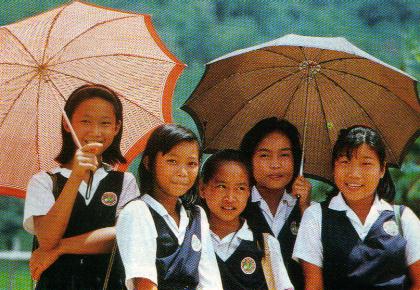
The People of Malaysia
A newcomer to Malaysia will be amazed by the colours of the country. Not only is Malaysia's
scenery fascinating, her population is colourful too. It is a microcosm of the best that Asia
offers.
While many Western countries are only now experiencing the challenges posed by multi-racial,
multi-religious societies, Malaysia has had such a society for more than a century.
Malaysia has perhaps the most multi-racial society in Asian. Malays and other bumiputras
comprise slightly more than 50 per cent of the 17 million people, while Chinese make up about 35
per cent. Indians, Eurasians, Portuguese and other minority groups make up the rest of Malaysian
society.

A local English newspaper once published a letter from an Englishman who found some form of heaven
in a fishing village called Marang in Terengganu. He did not know what to expect in his first
trip to Malaysia, but he ended up staying longer than he had planned to, in a budget beach chalet
in Marang. What entralled him was the rustic setting and the friendly, hospitable people who were
knowledgeable about world events.
Just take a drive to Terengganu and Kelantan in the East Coast or to Kedah and Perlis in the
north-western part of the peninsula and you will have a taste of such hospitality, where people
readily smile at you and wave back. Curious children will crowd around you and giggle. They will
even pose for you while you fiddle your camera. The slow pace of life there, where days pass
unnoticed, has a charm all its own. Once you get to know the fishermen there, you can hitch a
ride on their boat or even go on a fishing trip with them.
In Kelantan and Terengganu, you will discover that women's liberation took hold there long before
it became popular in the West. This is because womenfolk man the stalls and are effectively the
financial controllers of the household. Never let their amicable ways fool you; they can be
pretty sharp.

The Babas trace their ancestry to the 15th century in Malacca. Traders from China settled in the
thriving Malacca port and many married Malays. Thus the Baba culture is a blend of China and
Malay cultures. They can be found in Malacca and Penang and they have evolved a fascinating and
colourful culture unique to them. When you are in Malacca, take the trouble to visit the Baba
Heritage Museum at Jalan Tun Tan Cheng Lock where the colour of Baba culture from the pink and
blue porcelain to the glittering mother-of-pearl embedded furniture is showcased. It is possible
to visit other Baba houses along that road. Simply ask permission to enter.
There are minority groups like the Punjabis, who can be identified by their turbans and thick
beard; the Portuguese who are still living in Malacca, speaking language that is not even used in
present-day Portugal; the Siamese- Malays who live in the border towns with Thailand; the
aborigines (more commonly called Orang Asli); and the Eurasians, children of mixed marriages
between Caucasians (mostly British) and locals (mostly Malay or Chinese). The Caucasians have the
best of both worlds, inheriting the exotic features of the West and the mystique of the East.

Over in Sabah and Sarawak, the racial mix is astounding. In Sabah, the majority of the locals are
Kadazans and Dusuns whose colourful dresses and graceful dances add much colour to the rich
culture of Malaysia. Muruts, Kelabits, Kedayans and Baiaus (who look more like local cowboys when
they ride their horses) are the other minority groups.
Sarawak has a large ethnic group call Iban. Many of them still live in longhouses and any trip to
Sarawak is incomplete without a night's stay in an Iban's longhouse and a sip of potent
tuak, a sweet wine made from glutinous rice. Their hospitality is known the world over and
a visitor to a longhouse will have to down a glass of tuak at each doorway. Needless to say,
visiting an Iban longhouse can be an intoxicating experience.
Bidayuhs, Melanaus, Kenyahs, Kenyans, Bisayahs and Penans complete the racial mix.
 The ethnic groups of Sabah and Sarawak have little in common with the aboriginal groups in
Peninsular Malaysia. Anyone who has been to the National Park or gone trekking in the jungle
would have encountered the Orang Asli who are excellent hunters and trackers. Never attempt to
trek-in the jungle without an Orang Asli guide, otherwise you would end up walking in circles.
The ethnic groups of Sabah and Sarawak have little in common with the aboriginal groups in
Peninsular Malaysia. Anyone who has been to the National Park or gone trekking in the jungle
would have encountered the Orang Asli who are excellent hunters and trackers. Never attempt to
trek-in the jungle without an Orang Asli guide, otherwise you would end up walking in circles.
The Orang Asli are a friendly and gentle people. Some are still nomadic, like the Batek (who
come under the Negrito group) while others are settled, like the Jakuns (who are Proto-Malays).
They are by no means living in poverty as the authorities have built houses for them and have
provided them with training in various skills. Many Orang Asli are now educated and some even
speak English.

A consequence of many races in many religions. The Malays are Muslims while the Indians are
either Hindus, Buddhists or Christians. The Chinese are Taoists, Buddhists or Christians.
Kadazans and Ibans are mostly Christians while the Orang Asli are either animists or Muslims.
Thus almost all festivals of the world are celebrated in Malaysia, from the Lunar New Year of the
Chinese to Deepavali, the Festival of Light of the Hindus. The Malays observe the Muslim holy
month of Ramadhan by fasting during sunlight hours and celebrate Hari Raya Aidilfitri, which marks
the end of the 30-day fasting period and the beginning of the month of Syawal, a time for
rejoicing.
Some tour companies organise home visits during the festivals. Thus you can have a first-hand
experience of celebrating a festival Malaysian-style, with the concept of "open-house" taking
centrestage. In Malaysia, the people "open" their houses during festivals, and friends, neighbours
and relatives pay visits and have their full goodies and drinks. This way of celebrating festivals
is unique.
A visit to Malaysia during any festival will reveal the fascinating facets of her culture in a
more in-depth way.
BACK






